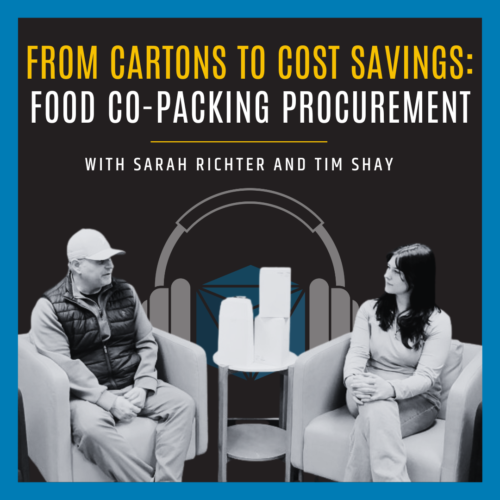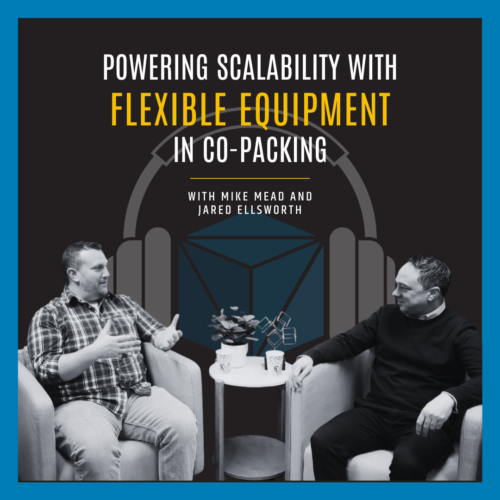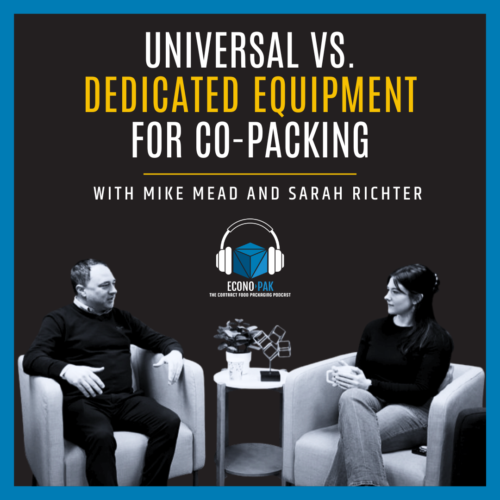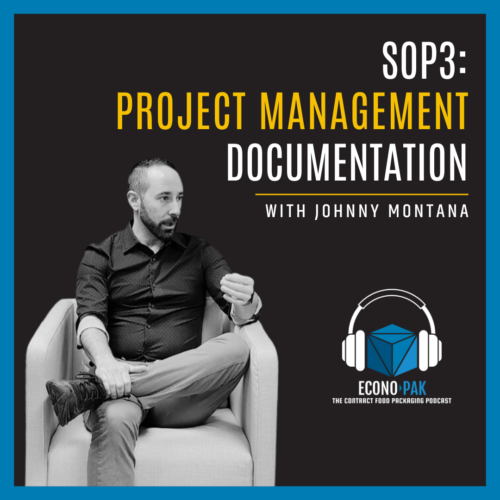Production Scheduling with Plant Manager Patrick Sullivan
In this Econo-Pak Food Packaging Podcast interview, Patrick Sullivan, our Plant Manager, details his remarkable journey within the company and the intricacies of contract food packaging production scheduling.
Patrick offers a unique perspective on career growth, operational challenges, and the dynamics of the food packaging industry.
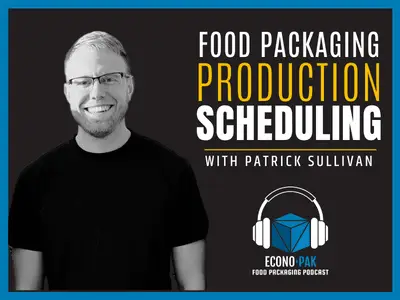
Crafting the Production Schedule for Co-Packing Businesses
Sarah Richter:
Welcome to the Econo-Pak Food Packaging Podcast. I’m Sarah, the Sales and Marketing Coordinator.
Mike Mead:
And I’m Mike Mead, the General Manager here at Econo-Pak.
Sarah Richter:
And we’re here with Patrick Sullivan, our Plant Manager. Welcome, Patrick.
Patrick Sullivan:
Hello, how are you guys doing?
Sarah Richter:
Great. Good. Yeah. So we want to ask you, we know you’ve had quite the journey here. Can you tell us about your entire career here at Ocon Pak? Starting from the beginning?
Patrick Sullivan:
Yeah, it’s quite extensive, so I guess I’ll keep it short. So basically I started here in 2015 as a general line worker and then got promoted to line leader. After that. They switched me up for a little bit and then I was a floater for products. I was like a product supply basically. After that, I think I did that for a year. They switched me to mechanic to work on the machines here. So that was another sidestep basically. And then I became the lead mechanic here on first shift. And then after that they changed me to the production scheduler. And then once I got a grasp of that, they switched me again to plant manager.
Sarah Richter:
And you keep saying “they switched me,” but I’m sure you had some initiative there.
Learning and Growth at Econo-Pak
Patrick Sullivan:
Definitely. Yeah. I mean, I’m one to push as much as I can and I have an intense way of working, so I like to basically get things done at a fast rate. So it goes to show, I guess, overall just because people see hard work and they know, you know what I mean? So I guess that’s helped me and I am very an organized person, so for me personally, I just like to have everything organized and I think that helped me along the way.
Mike Mead:
So you’re a fast-paced learner and aggressive learner. You want to learn new things and challenge yourself.
Patrick Sullivan:
Definitely. I mean, I feel like once I have an idea of something, I need to know every way of everything about it. You know what I mean? So I don’t know. For instance, some of the machines there, it was kind of tough in the beginning as far as a mechanic, but just getting the understanding of the machines from just the basics and then just working out. So it’s like I wanted to learn the basics and then learn everything about it in the mechanical way, electrical way, just every way possible.
Benefits of Inter-Departmental Experience
Sarah Richter:
And you have a ton of experience in so many different departments of Econo-Pak, so how does that shape your decisions as plant manager?
Patrick Sullivan:
I think it helps me all around just because going from the very bottom, working my way up, you get to work basically in every role all the way to where I am now. So I’ve done basically every job in the facility and then worked off of that. So you learn a little bit each way. So I feel like I’ve gained a lot just from going in small steps, you know what I mean? So those small steps just put me where I’m at and it’s taught me a lot about everything through the company. So it’s been beneficial, definitely. I mean, if there was someone that started new here and needed to learn, I would say start from the bottom and work your way up.
Mike Mead:
Yeah, it makes a lot of sense. That path. Personally, that’s my career path too, before Econo-Pak and here in the company, just trying to make sure I get involved in all the little projects, what might seem as small projects are very important to some of the bigger things that we work on as an organization, as a company. And it helps you also identify the right people, the people that report to you and their capabilities and how to grow your team and continue to develop your team.
Patrick Sullivan:
Definitely, definitely. Yeah, I mean for me it’s been a lot of people that worked here through the years with me. Some are still here, some are not here. But just from those certain people that have been here, even some that have left have taught me numerous things that probably I’d love to teach others, but it’s just like, it’s a lot of stuff that you go through working here. But I mean, overall it’s been a whole, I mean, from line worker to plant manager, it’s been a lot of just basically learning the food safety side of everything and then mechanical side of everything, production side of everything to basics of line workers also. So it’s just been a lot, but it’s been awesome.
Mike Mead:
Yeah. Yeah, that’s really interesting. At least my take in joining the company. I know you joined the company recently as well. It just seeing that there is a pathway for people to be able to develop themselves and to develop into different roles and learn new things and help you go through the process of getting into different departments. And I think that’s unique for the company, at least from my standpoint, how you feel about that.
Sarah Richter:
Yeah, I mean, working at other places, you’re kind of streamlined into one department and growth is kind of capped at that area. But here, I mean, if you have the motivation, you could go anywhere.
Mike Mead:
Yeah, definitely. We had an interview with Rohail, our Director of Quality, and he talked about continuous education is very important to him on a personal level definitely. But it’s also sharing knowledge is a big piece of it, and I don’t think that anybody can really grow in the company without sharing that knowledge. And it sounds like you kind of had a similar experience of people sharing their knowledge with you to help you kind of get into the position that you’re in today.
Patrick Sullivan:
Definitely, yeah, I feel like everybody that’s helped me along the way is molded me to where I’m at today. And I feel like I’ve learned everything because of going through those small bits and it’s definitely been beneficial the whole way. So it’s good to actually start from the bottom. I know for me personally, it’s been eight years, I think almost now that I’ve been here. So in eight years, I know, like you said, just with going into a certain company, sometimes you just go into your field and that’s really it.
And I’ve branched out to every field in this company, so it’s like you get the best of everything basically. The only spot that I didn’t go into, it’s like shipping, but prior to that, I was operating a forklift, got my forklift certification while I was doing the floating for the production supply. So it was just another thing that was, I was like, I want to basically be number one at that. Also, every position that I go into, I just tried to push for number one.
Mike Mead:
That’s awesome. Yeah.
Integrating Departments in Production Scheduling
Sarah Richter:
So a big part of your job is the production schedule. Can you explain for someone like me who doesn’t really know what that is, what is the production schedule and can you talk about key factors that you consider when planning it?
Patrick Sullivan:
Yeah, definitely. So for me, the production schedule, I work with customer service directly and key managers basically, we work off of each other and help each other as much as we can. But say if we get a new product, there’s always different varies, you know what I mean? So if we get a new product, it’s a startup, so basically, we’ll do an FPA, we have a project manager that takes care of that side of things, but we work with each other directly to make sure that everything basically is efficient, cost-effective, and takes care of the customer’s needs. However needed. I mean, there’s a lot of detail into that, so I won’t go too in-depth, but just in the grand scheme of things like for new items and everything like that, we just try to impress the customer as much as we can, as well as just not killing their pockets.
Mike Mead:
So you mentioned that you work with other departments to pull that schedule together. So it’s customer service, that’s the frontline communication with the customer, making sure that materials are going to be arriving on time and things are going to be here. That information that they provide to you is really what you use to kind of build that out. But you mentioned our project manager, and that’s a critical piece too, because that person is taking everything and making sure that we’re going to be set up for success when we do run.
So all those different phases you’re involved in each one of those. And again, I think it helps when you’re building the schedule today with a customer that maybe we’ve had for a year by working through all those different processes. And I think it’s really cool that the teams still get together even a year later, including a project manager, customer service, building out a schedule, are all still working on that with our quality teams and other teams within the organization. That’s pretty cool.
Patrick Sullivan:
Yeah, it’s awesome. I mean, it is helpful because if there’s any questions that are unanswered, you can just shoot to the next office and luckily be able to hopefully find that answer nine times out of 10 you can. So it’s definitely helpful to have all office members right here with us. So it’s been helpful.
Mike Mead:
Yeah, that’s great.
Capacity, Resources, and Scheduling in Contract Food Packaging
Sarah Richter:
So our capacity and our resources are constantly in flux. It’s just the nature of our business. So how do you ensure that the schedule is aligned with what we currently have?
Patrick Sullivan:
So basically, I work with shipping also that is another department that I work directly with. They obviously have a huge handle on things such as product cartons, anything of that sort. I work basically with our Shipping Manager, who is Millie. She gives me any information as far as incoming products, delayed products, stuff like that. So if we have any issues as far as products getting delivered to our doors, she’ll give me a heads up prior to, she’ll reach out to carriers, stuff like that. So I mean, she gives me insight on all that. We also have an Inventory Manager, Jessica, who helps me. You interviewed her. She helps me a lot. Also just giving us insight as far as cartons, how much we have on hand. They have direct counts basically every day of everything on hand, everything that you need or would need for an upcoming project.
So if anything, say we’re doing coffee cups for the next two weeks and the coffee cup labels are delayed, she’ll give me a heads up in advance just to say, Hey, the carrier reached out to us, we’re late by a day. I just figured I’d give you a heads up. So don’t schedule it prior to, you know what I mean? So with a lot of new customers, new projects, they help me a lot with what I need to as far as just basically startups, you know what I mean? So like a new client, anything like that.
Mike Mead:
When you determine your lead times, how much time do you need? A new customer comes in, they’ve run through their trial, we have everything dialed in, how much time do you need in order to get them on the schedule, and things like that?
Patrick Sullivan:
Typically, we can have it scheduled on the same day. We can make that happen relatively quickly as long as we have everything here. And we can usually give the customer a good turnaround pretty quickly. I mean, say if they came to us on a Tuesday saying, Hey, can you guys run this within the next two days? Depends on several things. Obviously, cart and shipper’s product, if we have everything, machine availability. So obviously these are all key factors that play into planning producting, you know what I mean? Everything like that.
Mike Mead:
Yeah. The reason I ask that is with our workforce and the way that we have the different people working on the lines, I know that you have set this up and our teams have set this up so that we have a dynamic workflow so people can work on different lines. They’re trained to do different things within the facility. So that gives a lot of flexibility on being able to move things around. So maybe like you said, corrugate doesn’t arrive for a specific project. It’s not like we can’t run, we’ll put it something else in its place. So we can be very flexible with that.
Patrick Sullivan:
Definitely.
Client Integration and Successful Turnarounds
Sarah Richter:
So could you share an example of what successful integration of a client looks like?
Patrick Sullivan:
Yeah, basically us just getting a product from one of our clients, basically giving them a fast turnaround. I feel like all clients want a fast turnaround as much as somebody says they’re not what customers always want in and out. So people are buying goods at all at the time. So a successful turnaround basically would be them sending us the product in. We would FPA it with our project manager. We would follow suit with that. After we get the results from our client that we are currently working with, we would just go from there. If pending, if they said no negative, we wouldn’t run it. Nine times out of 10, we typically get approval.
So we would just take that approval, put it on our production schedule and say if they put down 10,000 cases just for the week, just for instance, we would just shoot for that 10,000 for that week and then reallocate for the week after that. And then basically if the customer has a higher demand amount or if he wanted to increase, decrease, we would work with the customer as needed. From there, basically anything as far as in and outs, if they wanted a new project, obviously we have our customer service department that can just help us navigate us through that. And then for me, I just put it on a production schedule and then work with the maintenance team to make sure that we have a quick turnaround.
Mike Mead:
I try with new clients, new customers when I’m bringing them into it. So I’ll work on a quote for a customer. They accept the quote, they’re excited to start working with us. And like you said, everybody wants everything instantaneous, but there is a process that we have to go through. So we have to do our SOPs with our project management group, our quality director, getting all those documents in line, understanding a material schedule so that we’re have our shipping and receiving department understands when it’s going to come in. And I think all of those things kind of play a critical piece to building out a schedule. And a lot of clients we ask, we say, Hey, we’d like to have a forecast.
And some customers are hesitant to give us a forecast because they’re not exactly sure they’re working with us because of our flexibility. But the benefits of when they provide that forecast to us so that we can build a schedule around it allows us to allocate our equipment, allows you to determine how many people are going to be needed for each one of those projects, how we’re going to build those into the schedule. And I think that gives us the best success and trying to show our customers that had the importance behind a forecast and allowing you to build attainment schedule with our teams.
Patrick Sullivan:
Definitely. Yeah, I agree with that.
Sarah Richter:
I have a question just for myself, but so we run sellable trials, right? Are you involved in that? Is that part of your production schedule?
Patrick Sullivan:
So basically, again, I’d work with one of our project managers, just he would present it to me. He would shoot ideas from, Hey, this is the product we’re doing, this is the machine we’re using. Just basically get my insight on it and then we would work off each other and then plan it from there. I would basically, since we do it first, second, and third shift, I would either schedule it one of those shifts and then just go from there with the project manager.
The Importance of Collaboration in Project Success
Mike Mead:
And having those meetings too, to support what you’re saying about a sellable trial and an FPA first production. We have our weekly meetings, which we recap all of the data. So each of the departments comes in and reports from their angle. So our quality team reports like, Hey, these are the callouts, these are the things that we’ve seen. Maintenance will say, Hey, this was what we had to do with the equipment to dial it in. We had to make some different modifications and changes to it. Our shipping department, Hey, this is the way we had to stage the inventory and how we’re going to use it. So it is really cool how all of our teams come together for those weekly meetings and they’re highly productive.
And I love the fact that everybody comes to the table and Patrick, you organize those meetings and everybody comes to the table with their piece. And then I think that probably helps you then build a schedule and build a process around it with your team, right?
Patrick Sullivan:
Yeah, definitely. I mean, the meetings that we do have here are beneficial for sure, just because it’s like live time, it’s always real time. We’re working quickly every day. Different products different. There’s four different things that go into one item, and if you miss one of those things, then you’re down. You know what I mean? So you definitely have to pay attention to that. So it’s great that we have our meetings that we do have just because every single person that we need is on their managers, supervisors, and if there’s a call out, it’s ready to be called out. So I think those are key. Definitely our meetings.
Patrick Outside of Work
Sarah Richter:
So tell us what you like to do outside of Econo-Pak.
Patrick Sullivan:
Well, when I’m not hanging out with a bunch of people that do work here, no, me personally, I am more of an outdoors person. I like to fish, go camping. I have a boat, so I like to go on my boat. I actually just purchased land, so I’m a hands-on kind of guy. So I like to clear land. I like to basically get down and dirty. So anytime I’m not here, I’m outside fishing or working on something else that’s not relative to this. But for me it’s just outside. It’s
Mike Mead:
A nice escape.
Patrick Sullivan:
Exactly. Outside is my thing, you know what I mean? I guess we’re kind of cooped up in here. So me personally, even with the windows, I need fresh air. So I’m a big fresh air kind of guy. So outside of here, you’ll catch me outside. Awesome.
Sarah Richter:
Well, thank you for joining us today, Patrick. We really appreciate it.
Patrick Sullivan:
Thank you guys. I appreciate you having me.
Mike Mead:
Alright.
Subscribe to the Econo-Pak Food Packaging Podcast
We hope this interview has provided you with valuable insights into the world of contract food packaging and the vibrant culture at Econo-Pak. Patrick Sullivan’s story is not just about career progression; it’s a testament to the power of dedication, adaptability, and the importance of understanding every aspect of one’s industry. Stay tuned for more engaging content and in-depth discussions from the Econo-Pak Food Packaging Podcast.
Don’t forget to subscribe for more updates and insights from industry experts!
Let's start scaling.
Is your demand outpacing your ability to package your own product? Then consider outsourcing with Econo-Pak.
With over 40 years of experience working with both small brands and Fortune 500 companies, we are capable of handling your specific dry food product.
Get in touch with our team for a fixed-price quote for your project.

